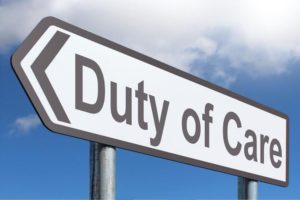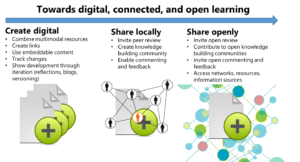Sadly I was unable to attend the Zoom meeting with Dr. Weller but I watched it and found it interesting that at on the webinar video (2:47) he said that “We are not very good at recording our history (of online learning)”. This got me thinking, especially when he mentions later three phases in chronological order; the “optimistic”, “mainstreaming”, and “pessimistic/critical phases”. History to me brings images of Caesar or Hitler rampaging through Europe, Western colonizers killing anything that moved on the North American plains, or Genghis Khan leading the Mongols hordes. Can history be used in terms of online learning given that it is a relatively new subject?
When I was younger I remember hearing from an adult,

If this is indeed true then one’s education is at least 100 years in the making and mine began in 1897. So what about online learning? Then I read Bates (2014) and saw how he links the various teaching theories to online learning and how the history of each does indeed go back, and each one’s relevance. Behaviorism developed 100 years ago depends on systems of rewards and punishments based on human behavior being predictable and many feel computer-aided learning is directly associated with online learning.
40 years ago Fontana (1980) said “The cognitive approach … holds that if we are to understand learning we cannot confine ourselves to observable behaviour, but must also concern ourselves with the learner’s ability mentally to re-organize his psychological field (i.e. his inner world of concepts, memories, etc.) in response to experience” (p. 148). Cognitivism plays a key role in online learning as there is now so much information available for the student to process.

Carl Rogers mentioned in his book “Freedom to learn” back in 1969 about the consciousness and freewill of people in learning and open learning takes away the strict classroom setting, much of the impetus of learning depends on the effort the student is prepared to put in on his own free will aside from the strict structure of the classroom, headmaster etc. Constructivism is social learning, and in online learning the student has the teacher and fellow students at his/her fingertips practically 24/7.
The Constructivism approach coupled with the invention of the internet brought us finally to where we are today, in the era of Online Collaborative learning. The teacher still remains fundamental to the system as has always been the case but this theory can augment the communication between all parties concerned. The only teaching theory without a real historical past is the relatively new “Connectivism” and as bates states it is probably too early to expect that as it is a new idea to look primarily at the implications of learning online through the internet with the continuing explosion of novel available communication technologies.
So to conclude online learning goes back way before the birth and development of the internet, the teaching theories have feet set firmly in history. It is over 100 years since Edward Thorndike the famous American educationalist said that behavior which is followed by good consequences is likely to be repeated, something that today’s student still appreciates.
References
Bates, T. (2014). Learning Theories and Online Learning. [Blog post]. Retrieved from https://www.tonybates.ca/2014/07/29/learning-theories -and-online-learning/
Rogers, C. (1969). Freedom to learn: A view of what education might become. Columbus. Ohio: Charles Merill.

Weller (2020) gives a well thought-out chronological order of how ed tech has changed and evolved over the last 25 years. However, it can be noted that of all the ed tech-related technology, only a few of them stand the the test of time and flourish to date such as e-learning, blogs, MOOCs, open textbooks, video, web 2.0, learning management systems and social media (to a lesser extent) among others. Application of technology in education has been clear but it is viewed as a separate entity, a soulless object. Therefore, I think it is important to evaluate ways in the education sector can give technology a soul in its applicability.
The way Weller (2020) describes these technologies, it feels as if they are used in a different space and time where a human element does not exist. When tackling the issue of learning management systems (LMS), Weller (2020) asks various questions that need to be answered especially at a time when online learning is so important. These include: “How do we make effective use of asynchronous/synchronous communication to enhance student interaction? Can we design the use of tools in courses to improve retention?” (p. 66).
As an experienced educator and instructor, Dr. DeWaard described the best ways to humanize online learning.
 I feel that this photo above summarizes the underpinning principle on how to humanize online learning. For instance, gesturing is one of the human elements that all educators need to incorporate into their teaching because online instructors or even students can forget that there is another human at the other end of the screen. Humanizing the learning experiences – it is about building relationships and building opportunities for conversation (conversation about the texts that maybe in the course or some weighty topics text to text, text to self which simply implies how do the readings or how does the piece of information that I’m reading connect to what I’m struggling with or experiencing in this context/ setting/ circumstances, and text to the world. Text to the world – how does it shape the world or fit into the bigger picture – by asking how have I impacted or supported the learning of others (building the ethos of care). How does it shape the physical world spaces that I’m engaged in? Not just about the reading or replying to discussion posts but about how am I supporting and connecting to the ideas of other people.
I feel that this photo above summarizes the underpinning principle on how to humanize online learning. For instance, gesturing is one of the human elements that all educators need to incorporate into their teaching because online instructors or even students can forget that there is another human at the other end of the screen. Humanizing the learning experiences – it is about building relationships and building opportunities for conversation (conversation about the texts that maybe in the course or some weighty topics text to text, text to self which simply implies how do the readings or how does the piece of information that I’m reading connect to what I’m struggling with or experiencing in this context/ setting/ circumstances, and text to the world. Text to the world – how does it shape the world or fit into the bigger picture – by asking how have I impacted or supported the learning of others (building the ethos of care). How does it shape the physical world spaces that I’m engaged in? Not just about the reading or replying to discussion posts but about how am I supporting and connecting to the ideas of other people.

Dr. Dewaard maintains that the ultimate goal of learning whether by asking why are you designing this learning space and how is it that you can build this space for engagement, representation, action, and expression. The ultimate aim is to build these spaces and help students become expert learners, and leave the course with some skills at how to access and how to build and how to internalize information. Although this is something many instructors do not pay attention to. The plan is already laid out but within the plan there’s enough space for voice and choice and it’s important to students from kindergarten through to higher education. It should include opportunities for them to present things that they are interested in, where they can dig deeper into something that caught their attention.

However, technology integration is a double-edged sword: While it can make us more powerful and help us overcome what appear to be insurmountable obstacles, it can also create more barriers if used improperly. France (2020) outlines some of the ideas that can help give a soul to online learning such as:
1. Move away from industrialized curriculum and toward journaling: It seems to make sense to turn to web-based, adaptive tools at a time like this and this is in line with Weller (2020) chronological development of ed tech. This makes it easier for teachers to manage teaching from afar and might make it easier to give lessons a personalized feel by creating playlists of activities.
2. Create opportunities for dialogue and discourse: Social interaction is a critical component of complex instruction. To fully capitalize on the benefits of complex instruction, we must create opportunities for dialogue and discourse, in an effort to keep kids thinking critically over the course of this quarantine. Many have audio or video conferencing capabilities at our fingertips. Google Meet and Zoom are just as important as the LMSs such as Blackboard, Moodle or Canvas explained by Weller (2020). In doing so, educators can preserve some semblance of normalcy and maintain the dialogue and discourse that we value in our classrooms.
3. Build in opportunities for self-reflection: The current crisis is allowing all of us—educators and parents included—to reflect on what it truly means to learn. We are being reminded that learning is more about the process than the product. Sending home worksheet after worksheet is unlikely to result in fruitful learning that will stick. As Dr. DeWaard said, the instructor is expected to have laid out the syllabus for the students because the syllabus comes first it’s almost a legal requirement for the instructor to have the syllabus ready. The plan is already laid out but within the plan there’s enough space for voice and choice and it’s important from kindergarten to students in higher education. It should include opportunities for them to present things that they are interested in, where can they dig deeper into something that caught their attention.
ETHOS OF CARE
Ethos of care is a main ingredient in making the humanization of online learning realistic.  As we forge ahead with the evolution of ed tech, Dr. DeWaard and Weller (2020)
As we forge ahead with the evolution of ed tech, Dr. DeWaard and Weller (2020)
ascertain that online spaces have to be accompanied by the duty of care. Weller (2020)
says, “As educators, it is important to acknowledge the type of negative aspects… and
not to unknowingly commit students to the use of technologies or approaches that
can lead to invasion of privacy or polarization. Higher education operates within
society, and so has a role in both shaping how the communities use such technology
and in holding technology companies to account” (p. 174).
References
France, P. E. (2020, Apr 1). 3 tips for humanizing digital pedagogy. Edutopia. Retrieved from https://www.edutopia.org/article/3-tips-humanizing-digitalpedagogy
Weller, M. (2020). 25 Years of ed tech. AU Press. Retrieved from https://read.aupress.ca/read/25-years-of-ed-tech/section/e69021f2-91b6-4ca4- 9d0b-81d3e9748707
Online learning rocks
First week glitches, mere pebbles
On long path to gold
(Japanese Haiku)
In her weekly email to the class Verena mentions a few initial glitches in the system and why some emails are not being received, how not all automated grades are being received all contributing to a lack of feedback. This has caused a certain hesitancy among members in the groups and class and led to a mild confusion. While others may have felt it more than me, it does give cause for reflection.
Any course is a journey and as Lao Tzu put it every journey needs a first step. That first step requires a firm footing and a roadmap of where one is going, plus preparation for the path ahead.

The purpose of this reflection is not to apportion blame. 2020 has been an extraordinary year, one that hopefully will never be repeated and the pandemic has affected all aspects of life, filtering down to the classroom. The three presences fundamental to the community of inquiry converge in the classroom and all three play key roles in ironing out initial glitches (The Community of Inquiry, n.d.). Lamb and Callison (2005) mention a “concrete interactive trail” which provides the instructor with a tool to identify issues by analyzing the cognitive presence among the groups (p.30).
If the group themselves feel that there is a lack of connectedness, this provides evidence as suggested by Nagel and Kotzé (2010) that work is needed on the social presence to increase a feeling of community to the whole group. As communication of feedback and such issues recede, confusion and/or any feelings of a lack of connectedness also fade leading to greater openness and improved communication and relationships within the groups.
Finally from the aspect of teaching presence, Barnes (2016) mentions the importance of drawing in the class members and making an atmosphere for learning, this has been done successfully as students were waiting, pen in hand (so to speak) ready to go. So, where facilitation and direct instruction are not the problem, perhaps the third component of teacher/instructor presence is, namely “design”. Barnes (2016) outlines indicators here including Organization and Technology. Without the correct use of technology and the smooth running of same, glitches will be inevitable.
Design is to facilitation and direct instruction as the foundations are to a building. If technology is not sound then it can upset all aspects of open learning as in this case where it was detailed and timely feedback, two of the cores of facilitation. Perhaps the increased pressure to integrate all aspects of privacy as we learned in Topic 1 were part of any technical issues but as constructive rather than destructive criticism is key to solving any issue, it is important to look at suggestions from all sides.
I feel that in the interests of increasing preparedness for online open learning, perhaps the idea of a dress rehearsal style quiz very early in the course could be beneficial. Students as part of the community of inquiry could be prepared on day 1, or even if it is possible within the frameworks of the technology or college rules to do a practice run, maybe even at T minus 7 days before the course begins, to test systems and ensure that everything is in running order, a bit like a soundcheck at a musical gig or concert. This would result in earlier communication between the group about how they did on the quiz or more importantly the purpose of the quiz, in seeking out through the three sources the basic and important information regarding data privacy.
References
Barnes, C.L. (2016). Where’s the Teacher ? Defining the Role of Instructor Presence in Social Presence and Cognition in Online Education. Humanizing Online Teaching and Learning. Retrieved from https://humanmooc.pressbooks.com/chapter/wheres-the-teacher-defining-the-role-of-instructor-presence-in-social-presence-and-cognition-in-online-education/
Lamb, A., & Callison, D. (2005). Online learning and virtual schools. School Library Media Activities Monthly, XXI(9), 7.
Nagel, L., & Kotzé, T. G. (2010). Supersizing e-learning: What a CoI survey reveals about teaching presence in a large online class. The Internet and Higher Education, 13(1), 45-51.
The Community of Inquiry (n.d.). CoI Framework. Retrieved from https://coi.athabascau.ca/coi-model/

Photo by Michael Paskevicius on digital, connected, and open learning
How can educators effectively build relationships by encouraging safe communication and interactions in online & open learning spaces?
Educators can effectively build relationships by taking advantage of the fact that many students increase their interactions when in an online situation rather than a traditional classroom. The online and learning space settings are unlikely to deter the vociferous or outspoken students to retract into themselves while the shyer student will find the online environment to be not as daunting or threatening. The educator therefore has a greater opportunity to exploit the full talents of all the class in a classroom that provides anonymity.
Too many students never read all the small print in the university rules and regulations, until they find themselves in difficulties. Already in this course the students have been directed to thorough reading of the rules governing personal information and privacy as indicated in the British Columbia’s Freedom of Information and Privacy Protection Act (FIPPA). The ethical issues concerning information privacy; anonymity; surveillance; autonomy; non-discrimination; and ownership of information as outlined by Regan and Jesse (2019), should be discussed. This simple quiz formula in our first assignment and exercises like this makes the student research, realize and understand their full rights and this builds trust which is the key of any relationship. Once the student feels secure they are more likely to open up.
Even before the building of relationships by encouraging safe communication and interactions in online & open learning spaces is considered by the educators, they should also monitor the progress of all the participants to make sure that they are not struggling with the logistics and technology to participate in the course, as the student will not wish to admit facing early difficulties, as it could be seen as failure to perform tasks or an admission of weakness.
In the online and open learning setting it is important to remember as Donne said “No man is an island entire of itself” (Domme, 1962). Cyberspace can be a lonely place but technology offers ease to communicate and perform group projects which encourage interaction. Classroom relationships are restricted to a few hours per week but online learning allows continuous opportunity to develop relationships as opposed to meeting the educator and fellow students say every Monday, Wednesday and Friday between 9am and 11am.
To conclude the best options for educators to build relationships by encouraging safe communication and interactions in online & open learning spaces are to firstly provide a suitable environment, to explain precisely the mechanics of the technology to ensure instructors and students are all on the same page, and finally through encouraging research group activity and quizzes and assignments, to allow the student learn how safe and secure the environment really is. The setting should be easier to integrate the whole class and encourage interaction as opposed to a classroom setting.
What did you already know, what do you know now based on the course readings and activities?
I had not really given online and open learning spaces a lot of thought outside of the fact that they were a useful tool as my educational career progresses. When the pandemic began back in early 2020 I recall predicting a boom in the field due to prevailing circumstances. My thoughts on the subject were based on practical thinking. But once the course I began to think of the ethical issues such as tracking, ownership of personal information. I had not considered the philosophy associated with technology and education.
Not only did the readings encourage me to read the FIPPA for the first time, I learned that the words “custody” and “control” are not defined as per the act, but on a serious note I got a full grip on what is classified as personal information and the individual rights that surround it. Nam Jun Paik in Howell Major (2015) states that “Skin has become inadequate in interfacing with reality. Technology has become the body’s new membrane of existence” (p. 9). This reading exercise describes technology’s role in education as; technology as context, as an extension of the self, as in interpretive lens and finally as a humanlike interface. This provides a lot of food for thought.
I also had not considered the teacher’s perspective as outlined in Howell Major (2015), I found educators such as Eloise Tan’s views very interesting when they discussed the problems they faced with the growth of online and open learning spaces ranging from initial nervousness to self-questioning on whether they could do it and had the necessary skills.
What do I hope to learn?
The short answer is I hope to learn a lot, as in the case of weeks 1&2. The course has got me thinking of questions such as what does research show in terms of the success of online and open learning as opposed to the success rates of students in the classroom setting. What are the external effects of online and open learning spaces on the student in terms of time spent using technology, does it cause addictions or abuses in that students spend a lot of time already interacting online and gaming online. How far can it go and what will the saturation point be and when will it be reached. Not all countries have the infrastructure to set up such education and will this increase the gap between the developed and developing worlds. Even internally in Canada and the U.S. will this new educational technology cause divisions if equal facilities cannot be afforded to all students?
References
Donne, J. (1962). Meditation XVII: devotions upon emergent occasions. Sermons of John Donne, 7, 369.
Howell Major, C. (2015). Teaching Online – A Guide to Theory, Research, and Practice. (Chapter 1). Retrieved from http://ebookcentral.proquest.com/lib/uvic/detail.action?docID=3318874
Regan, P. M., & Jesse, J. (2018). Ethical challenges of edtech, big data and personalized learning: twenty-first century student sorting and tracking. Ethics and Information Technology. doi:10.1007/s10676-018-9492-2